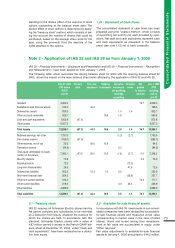APC 2005 Annual Report Download - page 76
Download and view the complete annual report
Please find page 76 of the 2005 APC annual report below. You can navigate through the pages in the report by either clicking on the pages listed below, or by using the keyword search tool below to find specific information within the annual report.
74
Companies acquired or sold during the year are
included in or removed from the consolidated financial
statements as of the date when effective control is
acquired or relinquished.
Intragroup balances and transactions are eliminated
in consolidation.
The list of consolidated subsidiaries and associates is
provided in note 30. Certain non-material subsidiaries
are not consolidated.
All of the companies included in the scope of consoli-
dation have a December 31 year-end.
1.5 - Business combinations
In accordance with IFRS 3 –
Business Combinations
– business combinations are accounted for using the
purchase method.
All identified acquired assets, liabilities and contingent
liabilities are recognized at their fair value as of the
date of acquisition. Provisional fair values are adjust-
ed within a maximum of twelve months following the
date of acquisition.
If the cost of acquisition is higher than the fair value of
assets acquired and liabilities assumed at the date of
acquisition, the excess is recorded under goodwill. If
the cost of acquisition is lower than the fair value of
assets acquired and liabilities assumed at the date of
acquisition, the negative goodwill is immediately rec-
ognized in the income statement.
Goodwill is not amortized, but tested for impairment
annually (see note 1.10 below). Any impairment
losses are recognized under "Other operating
income/(expense)".
1.6 - Translation of the financial
statements of foreign subsidiaries
The consolidated financial statements are drawn up in
euros.
The financial statements of subsidiaries that use
another functional currency are translated into euros
as follows:
Assets and liabilities are translated at official year-
end exchange rates.
Income statement and cash flow items are translat-
ed at average annual exchange rates.
Differences arising on translation are recorded in equi-
ty under "Translation reserve".
1.7 - Foreign currency transactions
Foreign currency transactions are recorded using the
official exchange rate in effect at the date the transac-
tion is recorded or the hedging rate. At year-end, for-
eign currency payables and receivables are translated
into the reporting currency at year-end exchange
rates. Gains or losses on foreign currency conversion
are recorded in the income statement under "Other
financial income and expense, net".
Foreign currency hedging is described below, in note
1.21.
1.8 - Intangible assets
Intangible assets acquired separately or as part
of a business combination
Intangible assets acquired separately are initially rec-
ognized in the balance sheet at historical cost. They
are subsequently measured using the cost model, in
accordance with IAS 38 –
Intangible Assets
.
Brands and other identifiable assets of acquired com-
panies are recognized in the balance sheet at fair
value, determined by qualified experts. The valuations
are performed using generally accepted methods,
based on expected future cash flows. The assets are
regularly tested for impairment.
Intangible assets other than brands are amortized on
a straight-line basis over their useful life or the period
of legal protection. The amortization charge is recog-
nized in "Cost of sales" or in "Selling, general and
administrative expenses", depending on the type of
asset involved.
Amortized intangible assets are tested for impairment
when there is any indication that their recoverable
amount may be less than their carrying amount.
Impairment losses are recognized under "Other oper-
ating income/(expense)".
Brands
Brands acquired as part of a business combination
are not amortized when they are considered to have
an indefinite life.
This is determined on the basis of:
Brand awareness.
The Group’s strategy for integrating the brand into its
existing portfolio.
Brands with indefinite lives are tested for impairment
annually and when there is any indication that their
recoverable amount may be less than their carrying
amount. When necessary, an impairment loss is
recorded.
Internally-generated intangible assets
Research and development costs
Research costs are recognized in the income state-
ment when incurred.
Development costs for new projects are capitalized if,
and only if:
The project is clearly identified and its related costs
are separable and reliably tracked.
The Group has demonstrated the project’s technical
feasibility and its intention to complete the intangible
asset and use or sell it, as well as the availability of
adequate financial resources for this purpose.
It is probable that the future economic benefits
attributable to the project will flow to the Group.
Development costs that do not meet these criteria are
expensed in the year in which they are incurred.
Capitalized development costs are amortized over the
estimated life of the underlying technology, which gen-
erally ranges from 3 to 10 years.
The amortization charge is included in the cost of the
related products and reclassified into “Cost of sales”
when the products are sold.
























